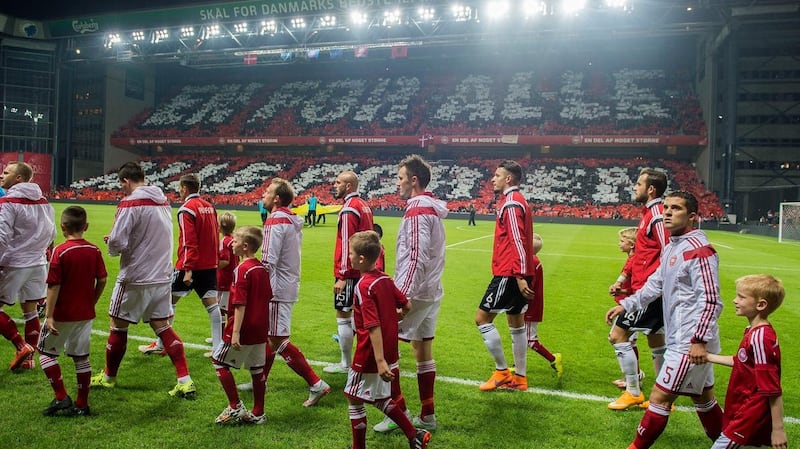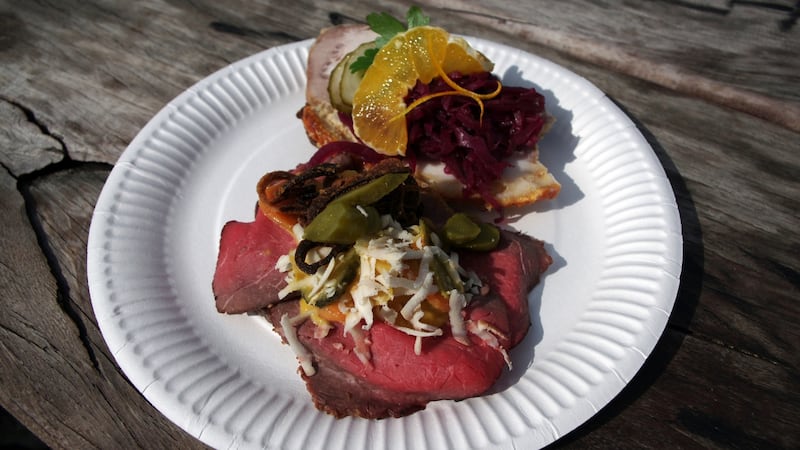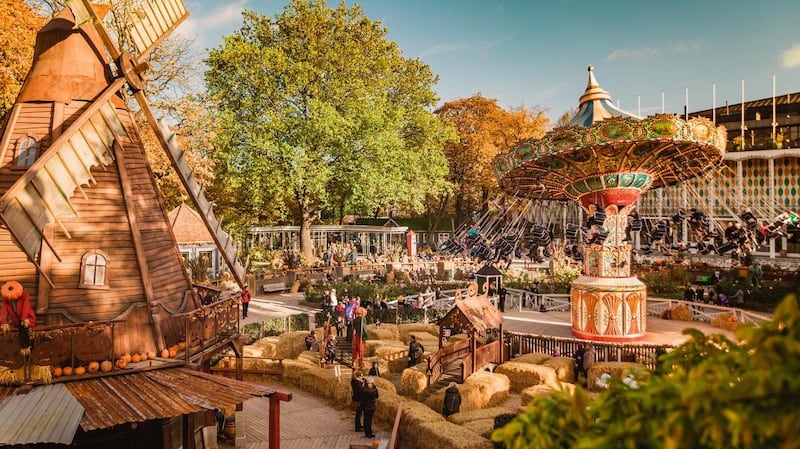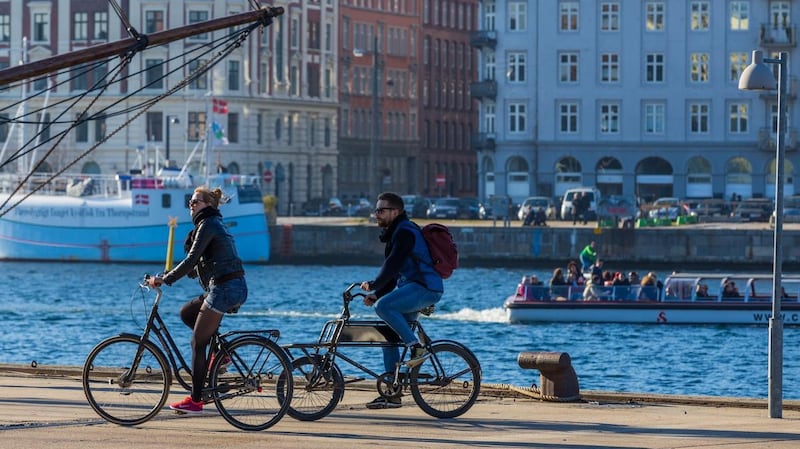Copenhagen. A capital city crammed with culture. A city of sophistication. Of calm. Of cyclists. And for one weekend only next month, it will be host to the Green Army. The Republic of Ireland takes on Denmark in the first leg of the World Cup play-off on Saturday, November 11th. We take a look at the what, where, when and how of travelling to the Danish capital.
Flights
Ryanair has direct flights to Copenhagen from Dublin and there are indirect flights with Lufthansa, KLM, SAS, Norwegian and Air France but here's hoping you have your flights booked by now.
Last week, a two-night trip around the play-off dates, with direct flights, were available for as little as €48 return with Ryanair. It’s no surprise that has changed. At the time of going to press, flying Ryanair from Dublin on Friday at 8.10pm cost €203.99. The return leg on Sunday is unavailable and Monday’s evening flight is €103.99.
The cheapest direct flight one-way to Copenhagen is with Scandinavian Airlines and will cost fans €65. A return flight to Dublin on Sunday is €105 with Norwegian Air International, but you will have to endure an 11-hour delay in Helsinki. It will, however, get you home in time for work on Monday morning.
The scramble for match tickets will begin on Thursday – applications can be made for the away leg at away.fai.ie. Fifa rules state that the visiting team must get at least 5 per cent of the overall ticket allocation, which would be just over 1,900 at Denmark's Parken Stadium. The ultimate amount could be closer to 10 per cent if the FAI can negotiate an agreement with their Danish counterparts.
Check Abbey Travel and other providers for charter flights and all-in deals.

Sleeping
When it comes to accommodation, Copenhagen has plenty to offer. Fans won't get the cheap deals that they would have been able to secure in Zagreb, but a three-star hotels in the city start from about €90, rising to over €600 for a five-star.
For a hotel with a difference and an unbeatable waterside view, try to nab one of the 12 rooms in Hotel CPH Living. There is nowhere else quite like it in Copenhagen. It is a floating hotel, in a converted German barge. It is permanently moored in the city centre so there's no chance of you losing your bearings after a night out. Just being a boat earns plenty of points on the character front and Danish design abounds, with simple, contemporary styling, natural woods and splashes of colour from original paintings and accessories. The rooms, spread over two decks, are compact but clean-lined and uncluttered, with hardwood floors and a nifty streamlined storage unit. Nightly prices for a double room over the match weekend start at €225.
If you are going to be sampling more than a few Danish beers, it might be best to stay on dry land. Andersen is a colourful, centrally-located hotel with a relaxed attitude and a 24-hour check-in concept. This means you get your room for 24 hours, no matter what time you arrive. It's a fun mix of minimal Scandi-chic and bright colours, with large black typography of cities across the globe stencilled on the walls. Look for free treats such as cookies and caramels. Rooms from €200.
Another hotel with an eye for style is the Radisson Blu Hotel, the first design hotel ever built. It even incorporated an airline terminal in a downtown hotel for the first time. It was built by the Scandinavian Airlines System, a merger between the national airlines of Denmark, Norway and Sweden, to serve as an international style gateway to Scandinavia, predominantly for the growing number of American tourists travelling across the Atlantic. It was designed by renowned Danish architect Arne Jacobsen and the unique Swan and Egg chairs can be found throughout the hotel. Room 606 is a living museum to the work of Jacobsen – it is the only room left untouched despite decades of renovations. Rooms start at €220 per night on the match weekend.

It might be a few years since you stayed in a hostel, but Copenhagen is just the spot to turn back the clock. Urban House by Meininger is a hostel-hotel hybrid in one of the hippest parts of the city – Vesterbro. As well as mixed dorms, where a bunk will cost you €29, private en suite rooms are available (€132). Six-person bunk rooms cost €194 in total and eight-person rooms cost €240. All beds include towels and there is free wifi and sockets beside each bed. Free city walking tours for guests depart daily.
Another hostel offering is the Steel House, a New York-inspired industrial-styled hostel. Housed in the former headquarters of the Danish Metalworkers's Union, it is a short walk from the central station and on the doorstep of one of the city's three adjoining lakes. Everything is stripped back here – there is no desk, chair or wardrobe. But who really needs them on a football weekend? Four and six person dorm rooms are smartest with each bed (€24) enclosed in a pod to give some privacy. There are also small double rooms (starting from €58). They charge extra to use the pool (€5.30), gym (€2.70 – an unlikely cost) or store luggage (€2.70), but given the overall charge, it's still a steal.
On Airbnb only 14 per cent of the properties listed are still available for Friday and Saturday night, but bargains remain. A bright apartment in the Østerbro neighbourhood that sleeps four people comfortably is €135 per night. This is same neighbourhood as the stadium, which is about 1km away. It is approximately 30 minutes from the airport. Bikes are included. Another apartment in the same neighbourhood by the waterfront is €108 per night and has one double bed and one couch suitable for sleeping. In Christianshavn, apartments are available from €150, sleeping three people. Most indicate a two-night minimum.
Eating
The Danish capital is fast becoming one of the greatest cities in the world for food, with René Redzepi's Noma largely responsible. While Noma itself has now closed, its success has inspired others and the most recent Michelin guide awarded 16 Copenhagen restaurants a total of 20 stars – the highest number ever. So, if fine dining is your thing, there is plenty to choose from but you will need to book online ahead of time to secure a reservation.
If you prefer to keep things simple, you can't go to Denmark without having an open sandwich, aka smørrebrød. The Danish staple offers a huge variety of combinations often presented as deliciously beautiful works of art. Head to effortlessly cool Din Nye Ven in Indre By, for a smørrebrød feast with toppings such as mackerel and smoked cream cheese or avocado stacked high on rye bread. Wash the generous portions down with a Danish beer, such as Pilsner or Mikkeller, and schnapps.

Copenhagen Streetfood hall is food hall meets art installation meets beach bar. According to local Kristina, who recommends the location through the Cool Cousin Copenhagen City Guide, "it has stolen hearts of Copenhageners with its amazing vibe, dinner for under 100DKK (€13) concept and beautifully decorated stalls with delicious dishes". Open daily, it is a chic and buzzy place to soak up local atmosphere while tucking into fresh food.
One of the most popular types of Danish pastry is the snegl (snail), which is a spiral cake packed full of cinnamon and butter, and topped with icing sugar. The direktørsnegl (director's snail) from Lagkagehuset is the perfect pick-me-up after a late night. Pick up a couple of snegle from the branch in Christianshavn and walk up the road to the free city of Christiana.
Drinking
If Carlsberg did World Cup play-off destinations... Copenhagen was the top pick for many football fans with a weekend sampling Danish beers being a popular swaying point. Copenhagen offers many establishments from which to sample the brews and the first has a name not easy to forget – Brus.
The Nørrebro brewpub Brus has a brewery, a long, smart-looking bar, and an experimental restaurant and a shop. Large oak barrels sit alongsige fermentation tanks and state-of-the-art brewing facilities and the brewery is constantly experimenting with new beer flavours. The brewery behind it all is TO ØL which is now world-renowned among beer enthusiasts and was set up by two local guys who attended school across the street. After hours, they brewed beer at the school as young apprentices of Mikkel Borg Bjergsø – who was then a teacher and is now a craft beer legend under the name Mikkeller. There are over 20 craft beers on tap.

Close to the Town Hall Square, you'll find the Brewpub microbrewery, pub and restaurant in an old protected house. There is a courtyard and the pub has at least 11 draught taps with ale flowing from the brewery's storage vats, as well as beers from other microbreweries and imported beers.
If you are travelling without a match ticket, check out Ørsted Ølbar, one of Copenhagen's go-to bars. It is a cozy bar that is easy to miss because it is surrounded by other bars or cafes just across from Ørsted Park. It has a large selection of beers and with more than 200 different bottles as well as 20 taps. And, most importantly, they show every soccer match that is broadcast in Denmark.
Neighbourhoods
Copenhagen is a city of neighbourhoods, all easily accessible by foot, bike or public transport. Ireland will play Denmark at the 38,065-seater Parken Stadium, which is accessible from any of the city centre neighbourhoods. It is is 4km from Tivoli, one of the best known areas in the city.
Tivoli and the town hall are divided by the city's busiest road but is on the edge of the Cultural District, which includes major attractions such as Ny Carlsberg Glyptotek, the National Museum and Christiansborg Palace. The Central Station is nearby and the area is home to the Tivoli Gardens. It's not often you find amusement parks smack bang in the city centre but this is Copenhagen after all.
The Tivoli Gardens date back to 1843 and is the second oldest amusement park in the world. Here you will find the world’s oldest wooden rollercoasters, Rutschebanen, and the Demon, a modern loop-the-loop, where riders wear a virtual reality headset. After dark, the gardens are lit up by hundreds of twinkling fairy lights. If you are bringing younger football fans, don’t miss it. There is a charge to enter the gardens (120DKK/€16), with an unlimited pass costing 230DKK/€31 or rides can be paid for individually.

Vesterbro neighbourood stretches west from Central Station and has largely cleaned up its act in recent years. Now hipster coffee shops, cocktail bars and boutiques outnumber the odd dodgy element. To enjoy its lively food and nightlife scene, head for Værnedamsvej, on the border of leafy Frederiksberg and Kødbyen (the Meatpacking District), where former butcher shops and slaughterhouses are now restaurants, clubs and galleries.
Christiania, officially known Freetown Christiania, was established in 1971 by a group of hippies who occupied abandoned military barracks on the site and developed their own set of society rules, completely independent of the Danish government. It is a green and car-free neighbourhood and was best known for its community-led utopia and tolerance towards cannabis trade. Last year, in the wake of a police shooting, the 800 or so residents of the freetown tore down the cannabis stalls on Pusher Street. If you visit now you will be greeted with organic eateries, vegan cafes selling beer and space cakes, rainbow-painted galleries, music venues, and innovative fashion boutiques. It is still a society within a society – you cannot buy a house in Christiania. You have to apply for it, and if successful, it is given to you. The area is open to the public – even with guided tours, run by the local Christianites. Visitors are advised not to film nor photograph in Christiania. At the entrance you will find signs indicating "do's and don'ts" in the area.
Not far away, visit the Church Vor Frelsers Kirke, where you can get one of the best views of the city. Pay €5 and trek up the 150 steps to the outdoor viewing point, surrounded by a golden railing. This might be one for the first day.
For another great view of the city, visit the Christiansborg Palace tower. At 106 metres it is the highest tower in Copenhagen and is free to access. Christiansborg Palace was once the home of kings and queens, but after one of several great fires, the royal family moved to Amalienborg Palace in the late 1800s and never returned. It was designed by architect Thorvald Jørgensen and is 40 centimetres higher than the city hall tower.
If Carlsberg did picture postcard selfie backgrounds (okay, we'll stop now), Nyhavn would be it. Dating from the 17th century, Nyhavn was constructed on the orders of King Christian V. For many years drunk fishermen "mingled" with prostitutes. Now colourful townhouses and warehouses have been converted into hotels and waterfront restaurants and it is a favourite place to sit outdoors and enjoy a drink with a rug tucked over your knees. Key attractions such as the Little Mermaid, Amalienborg Palace and main shopping streets are all within easy walking distance.
Of course, if you want to actually feature Carlsberg in your selfie, you can do that too. Visit the Carlsberg brewery (€13.50, or free with the Copenhagen card) to take a tour of the brewery and learn the history of the beer.

Getting around
To make the most of your time in the city, jump on a bike. Ask at your hotel for free bikes or rent one of the thousands of Bycyklen – electric bikes with built-in GPS to guide you. They can be found at docking stations dotted around the city. Register onlinewith a credit card to pay-as-you-go before picking up a bike. Hire is about €4 per hour.
Another good option is to pick up a Copenhagen Card but only if you plan on seeing more of the city than the inside of a few bars. The card gives free public transport by bus, train and Metro and free entry to 79 museums and attractions. One of the best ways to use it is on a boat tour down the canals around what's known as the Harbour Circle. You'll pass the colourful town houses of Nyhaven and stylish house boats, towards the striking Black Diamond Library, Amalienborg Palace (the Danish royal family's official residency) and the Little Mermaid statue. You probably know she was inspired by Danish author Hans Christian Anderson's fairy-tale, but did you know she has been decapitated twice and had her arm knocked off in various protests? The Copenhagen Card costs €53 for 24-hours, €74 for 48 hours and €89 for 72 hours.
What else you need to know
Temperatures in Copenhagen are about 14 degrees today but are set to drop from next week, with November daytime temperatures averaging at 5 to 7 degrees. Expect it to drop at night.
Copenhagen airport is approximately 8km from the city centre. According to travel search engine Kayak, public transport costs €5 (37.22DKK) and takes 13 minutes. Considering you will most likely be arriving en masse with Irish fans, share a taxi, which will take about 20 minutes and cost about €40 (297.75DKK).
Kayak’s research also tells us that supermarket prices in Copenhagen for a Brus are around €1.27 per beer – the same will cost you €5.86 in a bar, meaning an average saving of €3.56 for a drink.
Now that we know where we are staying, eating and drinking, let’s hope the hygge is with us.



















